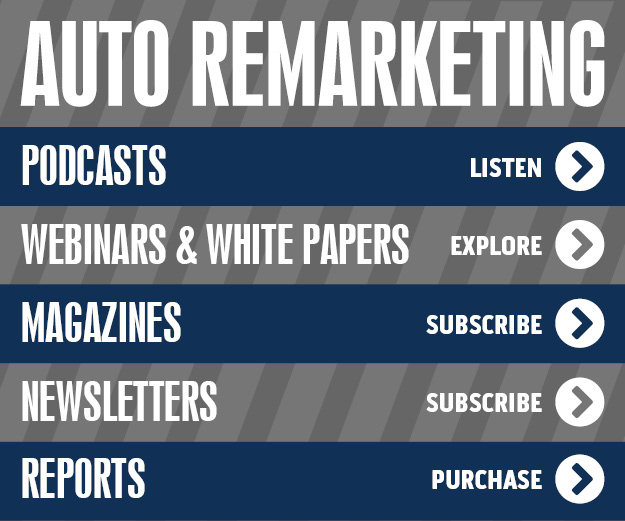The gap between averages associated with new-vehicle installment contracts and used-vehicle deals continues to widen, while the total amount financed as well as stretching terms are on the rise, too.
The industry reached a point on Thursday where Experian Automotive announced that the difference between the average monthly payments for new and used vehicles reached its highest level on record.
According to the latest State of the Automotive Finance Market report, the average monthly payment for a new vehicle in the second quarter of 2015 was $483, while the used was $361 — widening the gap between the two to $122, the largest margin since Experian began publicly reporting the data in 2008.
Furthermore, analysts determined the difference between the total loan amounts for new and used vehicles also increased significantly. On average, consumers financed $28,524 for a new vehicle and $18,671 for used — a difference of $9,853.
“As the price of new vehicles continues to rise, and the gap between monthly payments for new and used vehicles widens, we see more and more consumers looking for ways to keep their vehicle payments affordable,” said Melinda Zabritski, Experian’s senior director of automotive finance.
“This could be especially true for consumers who have the financial ability to pursue a new vehicle but may have sticker shock at the rising prices and don’t want the accompanying high monthly payments,” continued Zabritski, who again will be one of the presenters during the SubPrime Forum at Used Car Week.
Findings from the report also showed that consumers are continuing to extend their loan terms as a way to keep payments down, especially for used vehicles.
Experian indicated the percentage of used vehicles financed for 73 to 84 months increased by 14.8 percent from Q2 2014 to reach 16.1 percent — the highest percentage on record.
Additionally, analysts noticed new vehicles financed for the same term length climbed 19.7 percent from the previous year to reach 28.8 percent.
Leasing continues its popularity
During the second quarter, Experian found that consumers continued to select leasing as a popular option, as 31.4 percent of all new vehicles financed were leases, up from 30.2 percent the prior year.
According to the analysis, leasing terms also increased, with leases extending past the average of 36 months into the 37- to 48-month range increasing by 18 percent.
Moreover, Experian the average lease payment dropped $13 a month, going from $407 in Q2 2014 to $394 in Q2 2015.
“The automotive finance market continues to progress in response to consumer demand,” said Zabritski, who will be part of the collection of industry experts at Used Car Week that runs from Nov. 16-20 at the Phoenician in Scottsdale, Ariz.
“The availability of different financing options allows consumers to stretch their dollar and more easily find a vehicle that meets their budgetary needs,” she continued. “Lenders and automotive dealers also can benefit greatly from these trends by gaining insight that will enable them to take advantage of similar market opportunities in the future.”
4 other trends
Experian highlighted four other findings from its latest report, including:
• Used-vehicle financing is at an all-time high of 55.5 percent, compared with 53.8 percent the prior year.
• The total percentage of new vehicles financed in Q2 reached a record high of 85.8 percent, compared with 85 percent a year earlier.
• The average credit score for a new vehicle loan dropped two points from last year to reach 709. The average credit score for a used loan increased one point to 645 over the same time period.
• During the second quarter, the average interest rate for a new vehicle loan was 4.8 percent, up from 4.6 percent in Q2 2014. The interest rate for used-vehicle loans was 9.1 percent, up from 8.8 percent over the same time period.
GWC Warranty chief executive officer and president Rob Glander insisted the company’s bread-and-butter customers are dealer clients who are those small- to medium-sized independent dealerships that might not move as much metal as the big franchised stores but still want to be successful.
So the vehicle service contract provider has been on a quest this year in particular being that its GWC’s 20th anniversary to give these operators all the tools necessary to make presentations, enhance customer relations and leverage technology.
“Basically, we want to reinforce our brand messaging that GWC is the best in class used vehicle service contract provider, and we do it by trying to help dealers sell more cars,” Glander told SubPrime Auto Finance News during a phone conversation this summer. “We do it by giving them tools, better service, better products, better training and technology.
“This is a way of putting our money where our mouth is,” Glander continued. “We’re committed to giving them technology that’s going to make them more efficient regardless of how comfortable they are with it. It also helps them project a much more progressive image to their customers.
“New-car dealers sell an awful lot of used vehicles as well. We want our standalone independent dealers to be able to play with the same sort of confidence and professionalism that a new-car dealer has when they’re selling these vehicles. It levels the playing field,” Glander went on to say.
It’s not uncommon for salespeople at those franchised stores to be circling the showroom with an iPad in hand ready to help customers. This summer, GWC rolled out its own app for tablets so independents can do the same thing.
The company highlighted the GWC App features:
— Educational video library
— Interactive coverage selection tool
— Real-time, reactive virtual shopping cart
— Mobile rating engine with VIN scanner to create a fast, easy, user-guided experience for selling vehicle service contracts
“With any technology there are going to be early adopters who are all over things. We do encounter dealers that have tablets in their stores and they’re trying to make use of them,” Glander said. “But we do business with an awful lot of small and medium-sized dealerships across the U.S. They don’t get the training and resources from people coming into their dealerships all the time and offering the most up-to-date tools and technology.
"They’re oftentimes out there on islands by themselves. With the pace of change being what it is, these people have to figure out what they’re going to embrace and have to do it with cost in mind, too,” he added.
GWC rolled out the iPad app ahead of this year’s National Independent Automobile Dealers Association annual convention so company representative could be armed with the technology not only at the NIADA event but also when varios state associations have their gatherings, too.
“We’ve been tablet users for a long time. We’re big Apple people in here,” Glander said. “We said there’s got to be a way to get this technology out there for our dealers. We knew Apple will sell 250 million iPads so you know they’re out there. So how do you play in there? How do you get this in front of dealers in a way that makes it useful for them?”
After brainstorming for several months, GWC generated its app concept and hired a service provider to build the tool with the final step in the process taking about six weeks.
Those four primary app features are coupled with capabilities such as the customers being able to see exactly what level of VSC would do to their monthly payment as well as an eContracting portal so the whole delievery can be completed in a paperless process.
“It makes it very user friendly. It helps the dealer be more efficient and progressive regardless of their comfort level with the technology,” Glander said.
New Benefits for Elite and WealthBuilder Dealers
Along with this summer’s app rollout, GWC Warranty also introduced two new value-added benefits exclusively for its Elite and WealthBuilder Dealers — GWC Virtual Training and Covideo.
GWC’s new Virtual Training platform is an interactive online video training tool that is designed to offer helpful content for every employee in a dealership. Available content topics include:
—Compliance
—F&I processes
—Sales strategies
—GWC product information and more.
Ideal for new employee ramp-up and legacy employee refresher courses, the company also highlighted GWC Virtual Training also boasts testing and reporting functions to maximize retention and track progress. This value-added tool is being offered free of charge to both Elite and WealthBuilder dealers.
Covideo is a customized, branded video email marketing service proven to increase internet response rates by 77 percent, showroom shows by 27 percent, customer satisfaction by 10 percent and sales by 7 percent. Glander pointed out that Covideo is easy to use on any computer or mobile device and is useful for lead follow up, vehicle walk-arounds, thank you videos for buyers and more.
GWC is sharing the cost of Covideo with Elite and WealthBuilder dealers to offer the service at a discounted rate – a price exclusive only to GWC Elite and WealthBuilder dealers.
“At GWC, we help dealers sell more cars by providing products, service, technology and training to help build upon their success,” Glander said.
“In Virtual Training, we are providing a training platform that levels the playing field for many independent dealers competing with larger stores,” he continued. “With Covideo, we are offering a high-tech tool aimed at helping dealers project a more modern, progressive image to current and potential customers.”
To sign up for either of these benefits, Glander explained that GWC Elite and WealthBuilder dealers simply need to contact their GWC dealer consultant.
Online Dealer Portal Celebrates First Anniversary
While the company as a whole turns 20, GWC Warranty also had another milestone this summer as it hit the one-year anniversary of its online Dealer Portal
In one year, the GWC Warranty Dealer Portal received more than 45,000 vehicle service contract submissions, evolving from an online tool for dealers to rate and submit contracts electronically to a comprehensive Web-based platform used by more than 4,000 dealerships nationwide.
With 220,000 logins in the first year alone, Glander noted that dealers have found value in the Dealer Portal’s numerous tools and resources by implementing its flexible functionality into their business’ everyday processes.
With a new release of the Dealer Portal, its list of features now includes:
—Prioritized, rapid-response online claims adjudication for Elite and WealthBuilder Dealers
—Free access to GWC’s Virtual Training Platform: an interactive, user-friendly training resource available exclusively to Elite and WealthBuilder Dealers
—An educational video library with streaming, on-demand content designed to aid in selling a VSC
—Real-time, fully historical “contracts and applications” reporting complete with claims summaries for every contract ever submitted
—A virtual content hub where dealers can download electronic product brochures, detailed component coverage information, cost of repairs statistics and more
—Instant access to frequently used forms and documents, such as a digital sales waiver and user guides for various sales like the GWC Dealer App for iPads
—A comprehensive, up-to-the-minute snapshot of past contracts and rating sessions
—The lead-generating LogoBuilder application that quickly and seamlessly brands dealership inventory with extended protection to help build confidence earlier in the sales process
The fastest growing auto loan balances in nearly a decade and record loan dollar volumes? Check.
The lowest second-quarter 30-day delinquency rate in five years? Check.
Strong auto sales? Check.
Oh, and there’s balanced portfolio distribution amongst the credit tiers.
“The automotive loan market is working the way it’s supposed to, with loans being made, vehicles purchased and payments made on time,” said Melinda Zabritski, Experian’s senior director of automotive finance.
“The automotive loan market is gaining momentum while maintaining remarkable stability,” Zabritski added. “It’s a good sign for the economy overall.”
Experian Automotive lays out those signs in its latest State of the Automotive Finance Market report released Wednesday.
At the top of Experian’s list: the second-quarter’s $92 million year-over-year growth in total dollar volume for outstanding car loan balances This represented the steepest climb in dollar volume since 2006, the company said.
Total loan balances were at $932 billion Q2, an all-time high, Experian said. A year ago, they were at $840 billion.
Meanwhile, the National Consumer Credit Trends Report from Equifax released Monday said the total outstanding balance on car loans and leases combined as of June was at $1.021 trillion, which beats the year-ago sum by 10.5 percent. It says there are 73.7 million outstanding accounts, which is up 8 percent.
“Strong sales numbers in both the new-car and used-car markets, coupled with the availability of quality financing for consumers are a few of the main reasons the industry has reached the one trillion dollar mark," said Dennis Carlson, deputy chief economist at Equifax. “It clearly reflects that the improving economy has provided the impetus for consumers to replace their aging vehicles and begin to satisfy their pent-up auto demand.
Payments made on time
Looking at Experian's data, here’s another thing that make the current environment all the more impressive: the market has great stability these days when it comes to borrowers making payments.
In fact, the 30-day delinquency rate for the period was 2.32 percent, which was the best Q2 reading in five years, Experian said. A year ago, it was at 2.37 percent.
The 60-day level nudged up slightly, reaching 0.607 percent after coming in at 0.603 percent a year ago.
Not to mention, there appears to be a great deal of balance when it comes to the credit-tier distribution, Experian found.
Granted, the combined Q2 market share for subprime and deep-subprime loans climbed from 19.92 percent to 20.02 percent in the past year, but super prime’s share was up as well, growing from 20.68 percent to 20.99 percent.
“Overall, lenders are taking a balanced approach to their portfolios, with slight growth in subprime and deep subprime balanced by the uptick in loans to the super-prime risk tier,” Zabritski continued. “There really is nothing alarming about the growth seen in subprime loans, provided consumers continue to make timely payments.”
More on auto loan growth
Going back to Equifax’s data, the company said banks were seeing 10.1 percent growth in auto loan balances through June, with finance companies seeing similar patterns at 10.2-percent growth.
However, when it comes to the leasing segment, finance companies are way ahead; in fact, their leasing portfolios are seven times as big as those from the banks, Equifax found.
What’s more, the company notes that, “Finance companies are also growing originations faster than banks with 54.2 percent of all new auto accounts and 51.8 percent of dollar originations through April 2015 coming through finance companies.”
Offering additional context, Carlson noted: “The captive auto finance companies are supporting sales for the manufacturers, and dealers continue to work with independent auto finance companies to find the right loans for their customers, particularly in the non-prime space.
“This combination has led to finance companies growing slightly faster than the commercial bank segment.”
On the heels of the roll-out of a compliance tool, F&I Express recently launched ExpressQuote, a new feature added to the company’s cloud-based solution to help F&I managers provide customers with fast, accurate quotes on aftermarket products.
The company explained ExpressQuote can connect F&I managers to product and price information from a large network of aftermarket insurance product providers. With just the vehicle’s VIN and mileage, F&I managers can access what F&I Express insisted are “100 percent accurate” aftermarket quotes, set a limited time availability on the offer and print a document to give to the customer.
F&I Express management highlighted this process can allow dealerships to engage customers in a conversation about F&I products when they are in a different department. For example, customers might be much more receptive to F&I messages when they are in the service department getting work done on their vehicle.
“F&I Managers need a fast and accurate way to quote customers, even when they aren’t in the F&I office," F&I Express chief executive officer Brian Reed said. “With ExpressQuote, F&I managers can access pricing information from multiple sources in real time.
“Today’s auto shoppers are often time pressed and will want a quick quote from the dealership,” Reed continued. “ExpressQuote helps automotive retailers meet their customers’ expectations.”
Reed added that providing more F&I information to customers earlier in the shopping process can prove to be a significant advantage to automotive retailers in the long run, as better-educated consumers are often easier to close.
“It really comes down to a customer service issue,” Reed said. “Smart automotive retailers realize they need to provide customers with answers — right now. Answering a customer inquiry quickly and efficiently can often make the difference between winning and losing a sale.”
The launch of ExpressQuote arrived not long after F&I Express unveiled a tool to watch margins for compliance.
The Federal Reserve of New York reported an uptick in consumers who expect to apply for vehicle financing during the next 12 months, but two economists, including Cox Automotive’s Tom Webb, discussed the potential headwinds that might arrive within the employment market as well as consumer confidence.
First, the New York Fed indicated its Survey of Consumer Expectations for June revealed that 12.9 percent of individuals expressed a likelihood of applying for auto financing within the upcoming year. That figure is up from 10.8 percent of individuals who told officials their intentions a year earlier.
However, the survey also showed that 26.5 percent of those consumers believed they likely would be rejected for that financing, up from 23.6 percent recorded in June of last year. What’s interesting is the New York Fed noted that its pool of respondents for the June survey contained more individuals with credit scores of 680 or below (15.8 percent) than the one a year earlier (8.3 percent). Also, consumers with sterling credit (scores of 760 and higher) made up the largest demographic in last year’s survey pool, constituting 14.4 percent a year ago but only 12.2 percent earlier this summer.
Then, Cox Automotive’s Webb revisited a topic he discusses regularly in order to give finance company executives some guidance on how the economy is behaving and how originations might develop.
In the July edition of the Manheim Consulting Auto Industry Brief, Webb acknowledged that a lack of productivity is dimming prospects for wage growth, which, of course, is a key component to vehicle affordability.
In 2014, Webb pointed out that the U.S. economy had a net increase of 3.1 million jobs, a rate that was the fastest pace in 15 years. Webb also mentioned an additional 1.25 million jobs were added in the first half of this year.
“And, of vital importance to the auto lending industry, initial jobless claims (adjusted for employment) are at an all-time low,” Webb said. “Yet, legitimate concerns about the robustness of the labor market remain.”
Although total employment is now 3.5 million higher than the previous peak reached in January 2008, Webb indicated full-time employment is still 822,000 shy of its all-time high.
“This partly explains the weakness in wage growth during the recovery,” he said. “But there is also a more troubling force holding down paychecks — productivity.”
After what Webb described as a “natural bounce back” coming out of the recession, Webb cited federal data that showed annual labor force productivity never exceeded 1 percent between 2011 and 2014.
And in the first quarter of this year, the Bureau of Labor Statistics (BLS) determined productivity was up only 0.3 percent from its year-ago level.
“The drivers of productivity growth are complex,” Webb said. “And, although policies to reverse the secular decline will be difficult to enact and slow-acting, they are the only way to promote real wage growth over the long term.
“Minimum wage laws, overtime pay regulations and guidelines for executive pay are all a sideshow,” Webb continued.
With wages evidently not on a significant upward track, the situation makes the monthly payment component of the vehicle installment contract all the most crucial to the completing of a contract. As Experian Automotive highlighted in the latest State of the Automotive Finance Market report, the average loan term for new and used vehicles originated during the first-quarter increased by one month, reaching new all-time highs of 67 and 62 months, respectively.
Then in an interview with Bloomberg earlier this month, former Santander Consumer USA chief executive officer Thomas Dundon maintained that rising contract terms aren’t necessarily bad for the industry, especially in the subprime space.
“The data would tell you that as long as the payment is affordable and quality of the vehicles is improving, the math says you’d rather give more term so the customer can get a better car,” Dundon told Bloomberg in this report, adding that 72-month contracts may soon be the standard term for prime contracts, too.
Equifax deputy chief economist Dennis Carlson didn’t disagree with Dundon’s thinking, especially when considering the BLS data that Webb referenced.
“The issue is the cost of cars absolutely has gone up. If you look at the price of a new car today versus five or six years ago, it’s certainly gone up faster than wages,” Carlson said.
“I think many people when they purchase a car, whether it’s new or used, they’re really looking at a number they can afford to pay on a monthly basis,” he continued. “If a car costs a certain amount and you’re able to pay X, then your loan is going to require you to reach terms that meet that number. One way we have been seeing that is through the prevalence of longer loans.
“I certainly think that it’s a factor, but I don’t know if it’s the driving factor,” Carlson went on to say. “I certainly would agree that as discretionary income continues to increase, as wages increase, perhaps those longer term loans will be less necessary. I think time will bear out the truth of that statement.”
Whether consumers take out vehicle notes that last 36 months, 72 months or even longer, the confidence in their finances, employment and more likely will impact what kind of financing they take — if any at all.
Stifel, Nicolaus & Co. Fixed Income chief economist Lindsey Piegza recapped the latest report from the Conference Board and Haver Analytics that showed consumer confidence fell from 99.8 to 90.9 in July, the lowest reading since September of last year.
In the details, Piegza noted consumers’ assessment of current conditions fell from 110.3 to 107.4, a three-month low. She added consumers’ expectations, meanwhile, plummeted nearly 13 points from 92.8 to 79.9, the weakest reading in more than a year.
“Consumer confidence was expected to decline slightly at the start of Q3. It was not, however, expected to plunge as it did in the latest report, falling to a multi-quarter low,” Piegza said in her latest economic commentary.
“Consumers are clearly losing confidence in a more robust outlook for the U.S. economy amid growing concerns over stagnant business conditions, fewer jobs and declining income,” she continued. “As consumers lose confidence, they are more likely to tighten their purse strings, further restraining household spending.”
Piegza recapped that June retail sales fell 0.3 percent compared to an anticipated rise of 0.3 percent.
“Coupled with downward revisions to the previous two months, the miss for retail spending in the second quarter totaled a full 1 percent,” she said.
“As a consumer based economy, without the consumer happy and healthy, we have little hope of stability, let alone momentum, as we head further into the second half of the year,” she went on to say.
Westlake Financial Services and Equifax now have more data to support their argument that subprime auto financing can benefit individuals with soft credit histories, rather than create a negative situation some regulators and consumer advocates might believe.
Equifax recognized Westlake Financial Services on Tuesday as the national finance company whose customers saw the highest credit score increase over the term of their loan. This development was a follow-up to a white paper Equifax released extolling the significant benefits that subprime customers can receive when they got a second chance by successfully paying their vehicle installment contract.
According to Equifax research data, when comparing a national sample of 125,000 customers with auto loans originated in the 2014 calendar year, Westlake Financial Services customers produced the highest average credit score increase over the term of their loan.
“We focus on a loan structure that works long term for the customer, which helps increase their credit rating as payments are made over time,” said Westlake Financial Services group president Ian Anderson, the recipient of last year’s SubPrime Auto Finance Executive of the Year Award who is expected to a panelist again during this year’s SubPrime Forum during Used Car Week.
“Westlake strives to make our customers’ lives better,” Anderson continued. “By helping our borrowers increase their credit scores, we make it easier for them to qualify for loans and purchases in the future.”
Two of the most recent Equifax white papers highlighted the positive elements of subprime auto financing.
Last summer, Equifax chief economist Amy Crews Cutts and deputy chief economist Dennis Carlson highlighted the position in a white paper titled, "Not Yesterday’s Subprime Auto Loan." They reiterated the importance subprime financing to the future of consumers who have damaged credit profiles. The Equifax economists noted the positive consumer ramifications well known to finance company executives at institutions that specialize in subprime contracts such as the importance of quality transportation to enhance employment opportunities and how steady payment performance can possibly lead to a rise toward prime status.
“If a borrower with subprime credit obtains a loan from a financial institution that reports the complete payment histories of their clients to the national credit reporting agencies, and that borrower makes timely payments on that loan and other credit obligations, then over time that borrower’s credit score will likely improve, possibly enough to qualify for prime credit terms,” Crews Cutts and Carlson said.
Then at the beginning of this year, Equifax again found data that clearly backed up the claim, which the company shared in a report titled, "Subprime Auto Loans: A Second Chance at Economic Opportunity."
Equifax determined that over a three-year time period, those consumers with deep subprime credit scores that originated a subprime auto loan showed, in aggregate, a significant increase in their credit score. In fact, analysts highlighted those consumers improved their credit score by a median of 52 points, which is a 62.5-percent improvement over the median score change of the group that did not take out a loan.
And now the industry has the performance of Westlake customers to refute naysayers’ claims about the possibility of finance companies taking advantage of subprime customers.
“Westlake’s interest in our original article prompted us to examine, at a lender level, where the improvements of subprime customers graduating to near-prime and prime standing was the greatest,” Equifax auto finance leader Lou Loquasto said.
“Westlake and other subprime lenders like them should be lauded for giving the right customers the right loan, and for enabling them to get back on their feet,” Loquasto went on to say.
Discussions and industry highlights are all on tap to be a part of this year’s SubPrime Forum, which is set for Nov. 16-18 at the Phoenician in Scottsdale, Ariz. Registrations are already open and sponsorships are also available. More details can be found at www.usedcarweek.biz.
BillingTree highlighted a string of new developments on Wednesday, including the launch of Payrazr, a comprehensive suite of in-house developed payment solutions.
The company also revealed a completely refreshed corporate branding, redesigning its logo, adopting the tagline “Growing Payments with Technology” and revamping its website.
Officials explained BillingTree’s Payrazr platform can supply technology to complement payment processing, including payment portals, virtual negotiators, gateways, interactive voice response systems (IVR), virtual terminals, mobile, online billing and document management. This tool is supported by APIs for integration.
Blending in-house developed solutions with best of breed offerings supplied by a network of BillingTree’s current and proven product partners, officials insisted Payrazr can offer a comprehensive suite to serve almost every business’s or industry’s ‘card not present’ payment needs.
The Payrazr platform’s depth can allow customers and partners to drive revenue by offering their clients more payment channel options — while also helping to ensure compliance. Payrazr operates independently yet fully integrates with BillingTree's Merchant Services which include, credit and debit card payments, ACH payments, compliance services and more.
To facilitate the company’s expanded in house technology development which includes Payrazr, BillingTree underwent a significant branding refresh. The makeover included adding the tagline “Growing Payments with Technology' in what officials hope can more accurately reflect the company’s broader service offering.
They also redesigned the company logo to incorporate the new messaging and align to the Payrazr brand. The company also deployed a revamped company website — www.mybillingtree.com — to reflect the additional services and solutions.
“We are very excited about the launch of Payrazr and the company’s branding makeover, which further enhance BillingTree's holistic and comprehensive approach to payment processing solutions and services,”, BillingTree chief executive officer and president Edz Sturans said.
“The solutions within Payrazr enable customers to maximize revenue growth with technology while keeping them compliant and their data secure,” Sturans continued.
“As always, BillingTree backs our offerings with the best professional services, and with our in-house development capability — new innovation and services will be continually added to the Payrazr suite over the coming months and years,” he went on to say.
BillingTree will be debuting the Payrazr solution suite at the ACA International annual convention & expo in Boston next week. BillingTree staff will be on hand to offer demonstrations at booth No. 316.
BillingTree also will be highlighting this new tool and branding during Used Car Week, which runs from Nov. 16-20 at the Phoenician in Scottsdale, Ariz. For more details about the SubPrime Forum that’s a part of Used Car Week and more, go to www.usedcarweek.biz.
If buyers keep their vehicles for the duration of the installment contract, dealerships and finance companies likely won’t see these consumers again for another purchase until 2020 or possibly beyond — an assertion stemming from the record-setting term metrics Experian Automotive reported on Monday.
Analysts determined longer-term loans for both new and used vehicles are on the rise. According to the latest State of the Automotive Finance Market report, the average loan term for new and used vehicles originated during the first-quarter increased by one month, reaching new all-time highs of 67 and 62 months, respectively.
Findings from the report also showed that longer loans — those contracts with terms lasting 73 to 84 months — accounted for a record-setting 29.5 percent of all new vehicles financed, marking an 18.6 percent rise above Q1 2014 and the highest percentage on record since Experian began publically tracking this data in 2006.
Long-term used-vehicle loans also broke records, with loan terms of 73 to 84 months, reaching 16 percent in Q1 2015, rising from 12.94 percent the previous year — also the highest on record.
“While longer term loans are growing, they do not necessarily represent an ominous sign for the market," said Melinda Zabritski, Experian’s senior director of automotive finance and a keynote speaker for the SubPrime Forum later this year during Used Car Week.
“Most longer-term loans help consumers keep monthly payments manageable, while allowing them to purchase the vehicles they need without having to break the bank,” Zabritski said. “However, it is critical for consumers to understand that if they take a long-term loan, they need to keep the car longer or could face negative equity should they choose to trade it in after only a few years.”
Experian pointed out the average amount financed and the average monthly payment for a new vehicle also increased to record heights.
The average new-vehicle loan was $28,711 in Q1 2015, compared to $27,612 in Q1 2014. The average monthly payment for new vehicles also rose, moving from $474 in Q1 2014 to $488 in Q1 2015.
Additionally, analysts reported leasing continued to increase in popularity during the quarter, jumping from 30.22 percent of all new vehicles financed in Q1 2014 to a record high of 31.46 percent in Q1 2015.
During the same time period, the average monthly lease payment dropped to $405, down from $412 the previous year.
Furthermore, leasing credit loosened, as the average new vehicle lessee had a credit score of 718 in Q1 2015, down from 721 the previous year.
“Increases in vehicle financing are signs of a strong automotive market,” Zabritski said.
“By gaining a deeper understanding of current financing trends, lenders are able to stay competitive and better meet the needs of the marketplace, while consumers can use the data to become more educated on the different vehicle financing options and make a more informed purchasing decision,” she went on to say.
Zabritski mentioned a trio of other findings from Experian’s latest report, including:
— The average credit score for a new-vehicle loan dropped slightly, going from 714 in Q1 2014 to 713 in Q1 2015. The average used vehicle score moved slightly higher, from 641 in Q1 2014 to 643 in Q1 2015.
— The average used-vehicle loan was $18,213 in Q4 2015, up from $17,927 in Q4 2014.
— The average interest rate for new vehicles was 4.71 percent in Q1 2015, up from 4.54 percent in Q1 2014. Similarly, the average interest rate for used vehicles increased from 9.01 percent in Q1 2014 to 9.17 percent in Q1 2015.
There has been a spate of articles lately discussing concerns about elevated growth in the auto finance sector. Some have argued that increased subprime lending to low- and middle-income consumers could result in some of the same fallout that occurred in the wake of the subprime mortgage crisis. Others have bemoaned the asset-backed securities sector in general, as well as the fact that many auto loans are packaged into exotic deals and sold off to investors hungry for yield.
Most of these concerns seem unfounded. The subprime auto industry has been around for many years and historically, although anecdotes about poor underwriting can always be found, the rate of industry losses has been manageable. This situation would likely continue even if recent macroeconomic good fortune were to evaporate. Although the concept of a subprime mortgage was a radical idea in 2004, the notion of “no credit, no worries” in the auto sector has never been particularly controversial.
There are three main reasons for optimism regarding auto finance. First, the auto markets are inherently non-speculative. If you know of anyone stockpiling Toyota Camrys with a view to a quick flip then you have my blessing to panic about the state of auto finance. Second, if the economy goes south, favorable used-vehicle supply-side dynamics will eventually kick in to offset elevated default rates. Third, Americans love (and significantly rely on) their cars and will typically sacrifice much to maintain access to individualized transportation.
One recent trend in auto lending that does raise concerns, however, is the growth in longer-term loans. In the past, consumers would typically take a 60-month loan as the standard option to buy a new car, with some cash-strapped buyers possibly being offered a 72-month loan to get the deal done. Nowadays, many are signing up for 84- or even 96-month commitments, especially at the subprime end of the spectrum.
Some will say that since cars are now built better and last longer, the move toward longer-term loans is a reasonable development. Bear in mind that when the loan is finally exhausted ― be it after five, eight or 20 years ― the car owner will hold some equity, even if it is merely the salvage value of the vehicle. The question, though, is not whether a vehicle is still drivable after eight years. The more pressing issue is the relationship between the principal outstanding on the loan and the dynamics of the car’s market value at interim periods. How will borrowers behave if, after five years, their ride is under water, with three years of loan payments still to go? Will they keep licking the stamp?
To understand this question, it helps to quantify the equity remaining in the vehicle under some typical assumptions about loan terms. To assist in this endeavor, we can use Moody’s Analytics AutoCycle solution that forecasts of car wholesale values under stress economic scenarios at the make/model/year level.
Sample Scenario
Consider two different vehicles: One is the Toyota Camry, which is the fifth highest-selling vehicle in the U.S. and well-regarded in terms of its resale value. The other vehicle is the Jeep Wrangler, which is famous for its retention of value in the secondary used-vehicle market. We assume that they are both 2014 vehicles purchased in early 2014 and consider loans with two interest rates: one with a 12 percent APR and one for which a relatively good-quality borrower can negotiate a 6 percent annual rate. We also assume that the loan amount is approximately equal to the full economic value of the vehicle on the day of purchase. In other words, we assume that the down payment covers on-road costs, including any depreciation caused by merely driving the vehicle off the lot.
The projections indicate substantial seasonality. The source of this is the seasonal pattern in the outcomes of wholesale vehicle auctions, which form the basis of the projections developed here. Looking through these cycles and focusing on the trend, we see that under baseline macroeconomic conditions, the 60-month loan generates substantial amounts of equity in the vehicle across the entire forecast horizon. Camry owners with such loans can expect to end their term owning a $12,000 car outright, while the Wranglers will be worth slightly more at that point (the vehicles, as specified, have similar values on day one).
By way of contrast, when we assume an eight-year loan term, we see that the equity held in the vehicle never amounts to much. Under baseline conditions, we find that the Camry owner has just shy of $4,000 in the vehicle after a little more than two years, but this figure will decline as the vehicle ages and end the five-year forecast horizon a little higher than a grand to the good. The situation is a bit better for Wrangler owners: Equity in the vehicle will grow over time, albeit at a glacial pace, ending the five-year window at around $4,000.
In a dire macroeconomic scenario (the Moody’s Analytics S4 scenario), the situation for 96-month loans becomes even more tenuous. Wrangler owners’ equity does not start to turn positive until three years into their loan term, while Camry owners effectively never build a significant ownership stake in their vehicles. Specifically: For the Camry, the 96-month loan is almost $3,000 under water after three years, but for the Wrangler, it is closer to $1,000. In S4, the 96-month Camry loan remains under water through the entire forecast period. (Based on these numbers, Camry speculation looks like a fool’s errand.) By contrast, the 60-month loan terms yield positive equity at all points in time even in the event of a recession; the dynamics for a 12 percent APR loan are similar.
Possible Conclusions
We can draw several additional conclusions from this analysis. The first is that, in most respects, 96-month auto loans are effectively operating as unsecured loans. From the bank’s perspective, after costs are carefully considered, it is a toss-up whether the wholesale value of the vehicle will cover the outstanding balance of the loan, assuming a 96-month term and a “full economic value” starting point. This suggests that interest rates on 96-month loans really should be only marginally lower than on the equivalent unsecured personal installment loans made to borrowers with similar credit scores. The car might still be worth something after repossession, but only if a number of external factors go right for the bank.
One implication of this analysis is that if a 96-month loan is already effectively an unsecured loan, a bank might as well issue 108-month loans ― such a trend would make little difference to the likely dynamics of available vehicle equity. Then again, giving subprime clients 108 potential payments to miss would almost certainly be a losing proposition!
All joking aside, the final point is that down payments are obviously critical. With outstanding equity almost flat under the assumptions employed here, it makes sense for financiers to build a buffer into the terms of the loan in the form of a higher down payment. Lenders who grant these loans should nonetheless be aware that the borrower’s initial equity is unlikely to grow during the life of the loan. Further, the desirability of a large down payment likely negates the need for a 96-month loan in the first place.
“Sure, we can get you into a 96-month loan, but you have to pay $4,000 up front” is a lot less catchy than “no credit, no problem!”
Tony Hughes is the managing director of credit analytics at Moody’s Analytics. Hughes oversees the Moody’s Analytics credit analysis consulting projects for global lending institutions. An expert applied econometrician, he has helped develop approaches to stress testing and loss forecasting in retail, C&I, and CRE portfolios and recently introduced a methodology for stress testing a bank’s deposit book. For more information visit www.economy.com/autocycle
ACI Worldwide, a global provider of electronic payment and banking solutions, announced this week that Westlake Financial Services selected ACI UP Bill Payment Solutions to facilitate customer vehicle installment contract payments and possibly save the finance company millions of dollars in processing charges.
With ACI’s omnichannel bill payment approach, officials explained Westlake customers will be able to pay loans with a debit card or ACH (Automated Clearing House) — accepting payments through online, mobile, phone and text — resulting in improved efficiencies and significant cost savings.
With more than $2 billion in total managed assets and 270,000 customer accounts across all 50 states, Westlake expects to save 20 percent on its debit card payment processing expenses, which over time is projected to contribute $5 million in savings.
UP Bill Payment Solutions is designed to deliver consumer engagement, cost control and compliance, as well as improvements in efficiency, an area of focus for Westlake’s executive team.
“Before ACI, it would have taken us years to realize the efficiency gains that UP Bill Payment Solutions provide; as such, making the switch to ACI was an easy decision,” said John Mason, vice president of operations at Westlake Financial Services. “This cost savings, combined with ACI’s compliance and money transmitter licenses, set them apart from the other options in the marketplace.”
ACI Worldwide vice president and product line manager Scott Fitzgerald added “Massive regulatory changes, shifts in consumer spending and industry cost structures have created complexity in auto finance payment processing.
“We’re pleased to bring ACI’s 40 years of payments experience to enable successful auto finance companies like Westlake to profit from these changes,” Fitzgerald went on to say.











